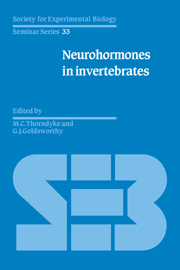Book contents
- Frontmatter
- Contents
- List of contributors
- Preface
- What is special about peptides as neuronal messengers?
- Part I Immunocytochemistry and Ultrastructure
- Part II Arthropod Neurohormones
- Part III Neurohormones in Coelenterates, Annelids and Protochordates
- Structure, location and possible actions of Arg–Phe–amide peptides in coelenterates
- Neuropeptides and monoamines in annelids
- Functional aspects of peptide neurohormones in protochordates
- Part IV Neurohormones in Molluscs
- Index
Neuropeptides and monoamines in annelids
Published online by Cambridge University Press: 04 August 2010
- Frontmatter
- Contents
- List of contributors
- Preface
- What is special about peptides as neuronal messengers?
- Part I Immunocytochemistry and Ultrastructure
- Part II Arthropod Neurohormones
- Part III Neurohormones in Coelenterates, Annelids and Protochordates
- Structure, location and possible actions of Arg–Phe–amide peptides in coelenterates
- Neuropeptides and monoamines in annelids
- Functional aspects of peptide neurohormones in protochordates
- Part IV Neurohormones in Molluscs
- Index
Summary
Amongst invertebrates, few bioactive peptides have been sequenced and, of these, most are from molluscs or arthropods and there are, as yet, no sequenced neuropeptides from the annelids. In spite of this paucity of information, we expect that a range of model systems will be developed within this phylum. The failure to sequence any annelid peptide is therefore unfortunate in view of the experimental opportunities provided by the nervous system (NS) of various species (leeches and polychaetes). From an evolutionary point of view, annelids are basic to the phylogeny of numerous animal groups. Knowledge of the structure of their neuropeptides is therefore of interest for comparison with those of invertebrates either more primitive (Hydra, Schaller et al 1984, see also Chapter 10 this volume) or more advanced (molluscs and arthropods, see Chapters 5-9 and 13-15 this volume).
Studies on neuropeptides are approached in two ways: the first involves a neurophysiological and neurobiological analysis directed towards an understanding of neurone physiology and more particularly the role of peptides in neurotransmission and neuromodulation (O'Shea & Schaffer 1985; see also Chapters 8 and 14 this volume). The pioneering work of Stent has established the leech as an important annelid model for the study of the cellular basis of behaviour (Stent & Kristan 1981) and as a model for neuronal development (Stent et al. 1982). The second approach is neuroendocrinological and is based upon a study of the production of peptides by neurosecretory centres in the central nervous system (CNS). Annelids have no discrete endocrine glands except for the infracerebral region (ICR), a neurohaemal area (fig. 5) found in several polychaetes (Dhainaut-Courtois 1970; Golding & Whittle 1977; Olive 1980; Durchon 1984).
- Type
- Chapter
- Information
- Neurohormones in Invertebrates , pp. 219 - 234Publisher: Cambridge University PressPrint publication year: 1988
- 7
- Cited by

